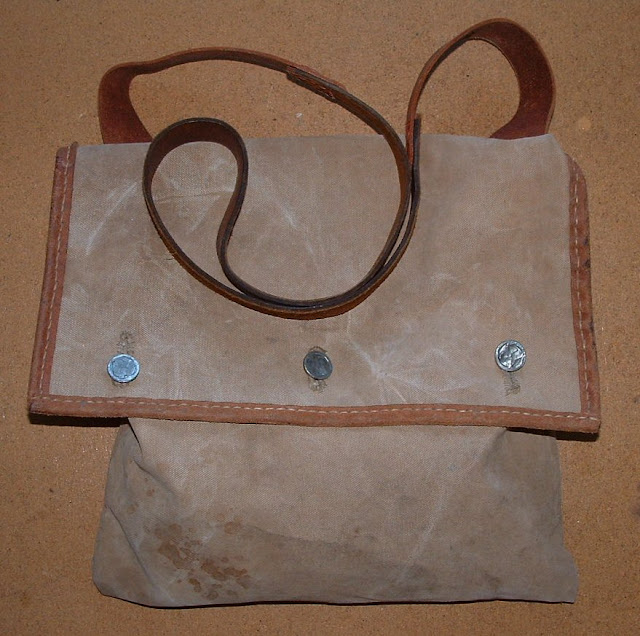Knapsack with bedroll, added market wallet, oilcloth and spare moccasins.
The Snapsack.
The Haversack.
Market Wallet.
One of our group members, Deerslayer, trying out the bedroll and tumpline for the first time.
The choice of which pack you use is not one of period correctness, all four of these packs are authentic to the period, it is simply a matter of personal preference. The choices now are no different to 300 years ago. You simply have to think about what you are going to carry, and then choose the best pack to carry it in.
I think we can all agree that we want to carry a blanket roll and possibly an oilcloth. I tie my blanket roll to my knapsack straps, and my oilcloth is secured under the flap of the knapsack. If you are using any other pack, you need to think about this.I carry a trade kettle. Not everyone wants to, I do. My kettle carries easily inside my knapsack.
This detail of "Indians Going A-Hunting" by Von Reck shows an Indian carrying a kettle on the very top of his pack.
The purpose of a longhunter was to hunt for deer skins. They did not trap them, they hunted and shot them. This means that they required lead, gunpowder, and guns. They would also need a ball mould and a lead ladle. If the gun broke, they were a long way from home, so it seems feasible that they would also carry spare gun parts and tools. These are the things you need to think about in the abscents of any documentation.
Now what else do you consider you need to carry?
"He was on horseback; I on foot
bearing my knapsack".
"After breakfast, I bade my host
farewell, buckled on my knapsack and left".
Daniel Boone. The Project
Gutenberg EBook of Daniel Boone, by John S. C. Abbott








4 comments:
Good post.
Thank you, I love looking at (and reading about) traditional old bags (no pun intended).
I especially like the snapsack.
Beautiful, well-planned kits !
I find it a challenge to look at your kits tho because I live in a RAIN-forest climate. I made an oil-cloth with linseed/turps to wrap everything in, and it became black with mildew ! I think the linseed was food for the mildew!(Linseed oil is store-bought anyway so I gave up on that route.)
To make my leather things water resistant Bark-Tan everything and then gently heat the article by the wood-stove and apply rendered tallow. I don't keep bees to obtain bees-wax and I've heard if it gets hot that it can become liquid again and smear all over the place. (I don't use parafin wax because it's store-bought for me and I'm learning unplugged methods from my local area.) Smoking canvas over my fire (well above the heat) covers things in creosote and really helps to make it water-resistant. I've tried to find out if 'seal-skin' or some other animal hide from my area could be used ....the Innuit friends I've asked said that way up north where it's 'dry' they never smoke their seal-skin to make it water-proof. Down here the rain would just rot a seal-skin. If they walk on wet snow in the spring I wonder how they keep their foot-wear, made from hides, from getting soggy and rotting. I think you can hear what I'm up against. Any other (non-store-bought,un-plugged)water-proof ideas would be greatly welcomed.
Gumbootmama I use beeswax, & it seems that original methods also used beeswax. I would certainly be exploring the use of seal tallow though. It seems you will just have to work with whatever is available in your area.
Regards, Keith.
Post a Comment